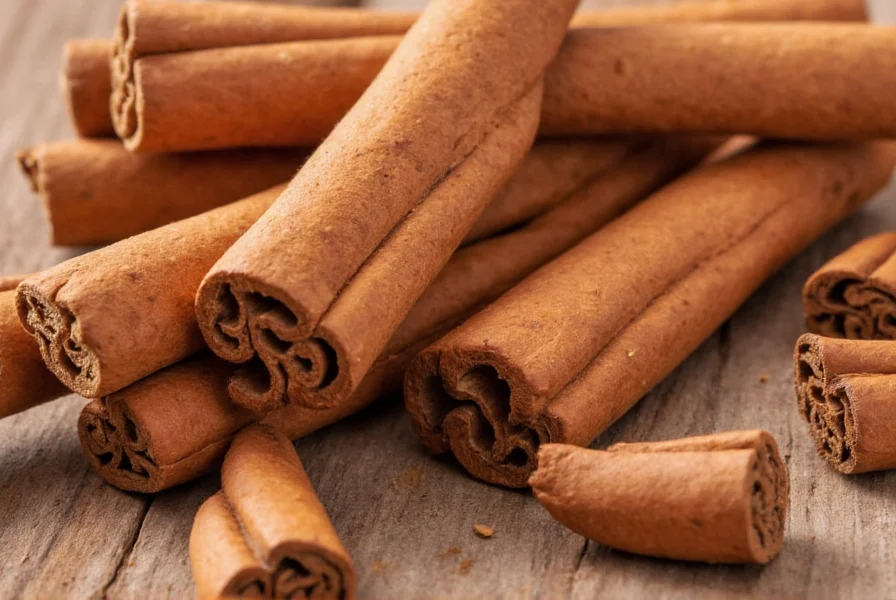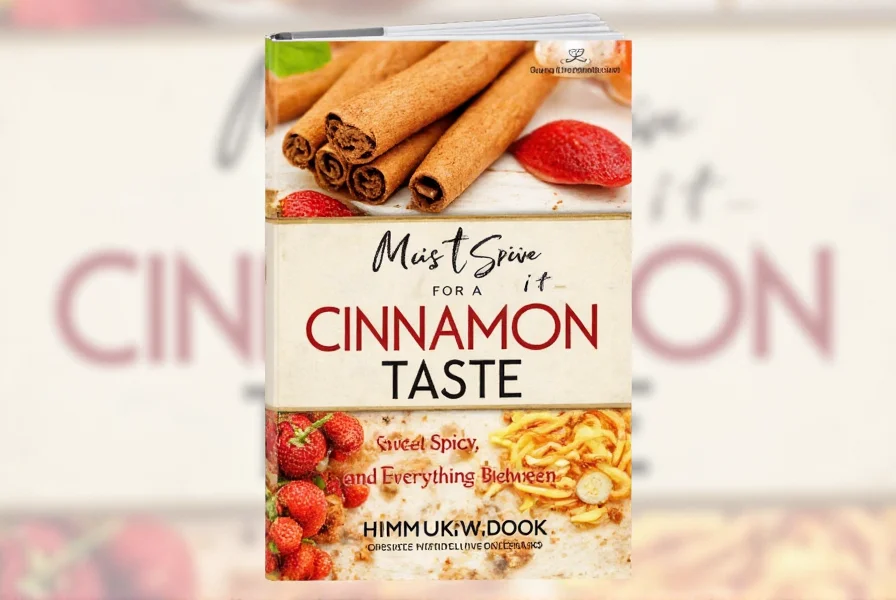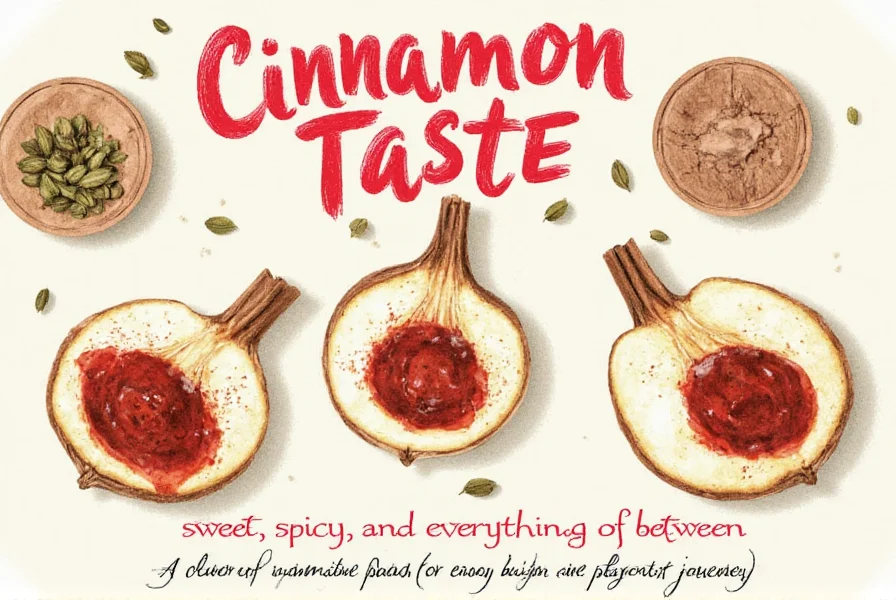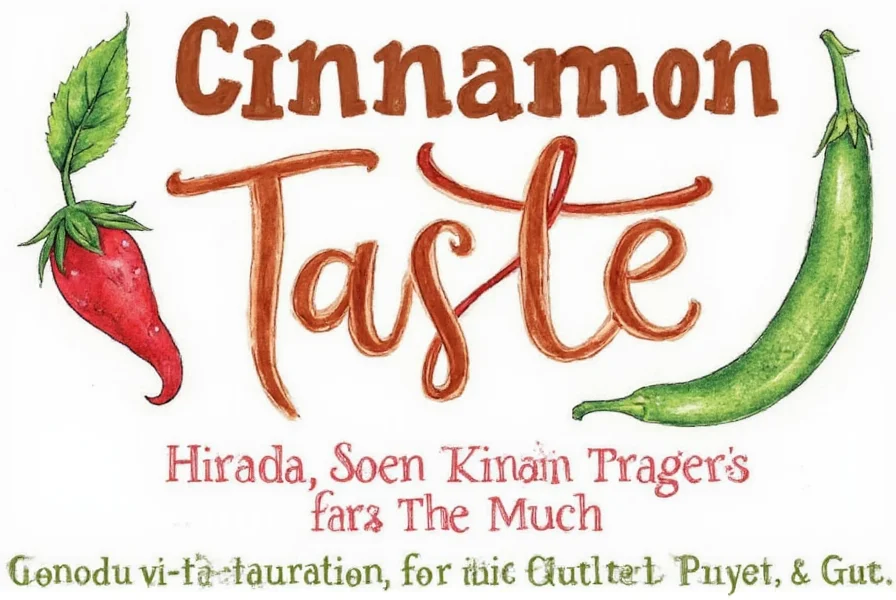Cinnamon taste is primarily warm, sweet, and slightly spicy with woody notes. This beloved spice offers a complex flavor profile that includes natural sweetness from its sugars, a gentle heat that lingers without overwhelming, earthy woody undertones, subtle floral hints, and sometimes slight bitterness - especially in Cassia varieties when used in excess. Understanding exactly what cinnamon tastes like is essential for using it effectively in cooking and baking.
Table of Contents
- What Is Cinnamon?
- Detailed Flavor Profile: What Does Cinnamon Taste Like?
- Ceylon vs. Cassia: How Taste Differs by Type
- How Cinnamon Taste Transforms Dishes
- Best Flavor Pairings to Enhance Cinnamon's Taste
- Buying Guide: Selecting Cinnamon for Optimal Taste
- Frequently Asked Questions About Cinnamon Taste
- Conclusion
What Is Cinnamon?
Cinnamon comes from the inner bark of trees belonging to the genus Cinnamomum. When dried, it forms the familiar cinnamon sticks or quills, which can be ground into powder. Used for thousands of years across various cultures, cinnamon serves both culinary and medicinal purposes - from Indian chai to French pastries.

Detailed Flavor Profile: What Does Cinnamon Taste Like?
When asking what cinnamon tastes like, the answer reveals a sophisticated symphony of flavors:
- Sweetness: Natural sugars provide a pleasant sugary undertone without actual sugar content
- Spiciness: A subtle warmth that enhances without burning
- Woody Notes: Earthy elements reminiscent of forest floors or aged wood
- Floral Hints: Delicate aromatic notes, particularly in premium varieties
- Bitter Undertones: More pronounced in Cassia when used excessively
This balanced complexity makes cinnamon uniquely versatile for both sweet and savory applications.
Ceylon vs. Cassia: How Taste Differs by Type
Understanding the taste difference between cinnamon varieties is crucial for culinary success:
| Type | Origin | Taste Characteristics | Best Culinary Uses |
|---|---|---|---|
| Ceylon Cinnamon | Sri Lanka | Sweet, delicate, citrusy notes, subtle warmth, minimal bitterness | Desserts, beverages, delicate sauces, breakfast dishes |
| Cassia Cinnamon | China/Indonesia/Vietnam | Strong, bold, pronounced spiciness, noticeable bitterness in larger quantities | Spiced dishes, hearty baked goods, stews, robust recipes |

Ceylon cinnamon, often called "true cinnamon," features thinner, multi-layered bark and a refined, nuanced flavor profile with subtle citrus notes. This premium variety contains significantly less coumarin (a compound that requires consumption moderation) and commands higher prices due to limited production.
Cassia cinnamon, the common supermarket variety, has thicker, single-roll bark and a more aggressive flavor profile. While more affordable and widely available, its stronger taste and higher coumarin content make it less suitable for daily consumption in large quantities.
How Cinnamon Taste Transforms Dishes
The cinnamon taste experience changes dramatically based on application method and timing:
- Temperature Impact: Heat enhances cinnamon's sweetness while mellowing its spiciness - perfect for baked goods and simmered dishes
- Form Matters: Whole sticks provide subtle infusion in liquids, while ground cinnamon delivers immediate, robust flavor
- Timing: Adding cinnamon early in cooking allows flavors to meld; adding late preserves its aromatic top notes
- Quantity Effects: Small amounts enhance complexity; excessive use can dominate and introduce bitterness

Optimizing Cinnamon's Taste in Recipes
- Toast Whole Sticks: Dry-toast for 60-90 seconds to intensify aromatic compounds before use
- Fresh Grinding: Grind sticks just before use for maximum flavor impact (30% more volatile oils than pre-ground)
- Proper Storage: Keep in airtight containers away from light; sticks maintain freshness up to 12 months, ground cinnamon 6 months
- Measurement Precision: Use 1/4 to 1/2 teaspoon ground cinnamon per cup of dry ingredients for balanced flavor
Best Flavor Pairings to Enhance Cinnamon's Taste
Certain ingredients amplify specific aspects of cinnamon's flavor profile:
| Ingredient | Effect on Cinnamon Taste | Recommended Ratio | Ideal Application |
|---|---|---|---|
| Vanilla | Enhances sweetness, softens spiciness | 2:1 (vanilla:cinnamon) | Crema catalana, custards |
| Nutmeg | Deepens earthy notes, adds complexity | 1:1.5 (nutmeg:cinnamon) | Pumpkin pie, spiced cakes |
| Orange Zest | Highlights citrus notes in Ceylon | 1 tsp zest per 1/2 tsp cinnamon | Breakfast oats, fruit compotes |
| Dark Chocolate | Creates rich, sophisticated warmth | 1:2 (cinnamon:chocolate) | Hot chocolate, chocolate cakes |

Buying Guide: Selecting Cinnamon for Optimal Taste
Choosing the right cinnamon variety dramatically impacts your final dish's flavor:
| Type | Taste Quality Indicator | Price per Ounce | Recommended Brands | Best For |
|---|---|---|---|---|
| Ceylon Sticks | Multiple thin layers, light tan color, sweet aroma | $8-$15 | Frontier Co-op, Simply Organic | Delicate desserts, beverages |
| Ceylon Powder | Lighter brown color, fine texture | $6-$10 | Nu Spice, King Arthur Flour | Daily baking, smooth sauces |
| Cassia Sticks | Thick single roll, dark reddish-brown | $2-$4 | McCormick, Badia | Robust recipes, simmered dishes |
| Cassia Powder | Dark brown, coarser texture | $2-$5 | McCormick, Simply Asia | General baking, spice blends |
Taste-Based Selection Tips
- Freshness Test: Rub between fingers - fresh cinnamon releases strong, sweet aroma immediately
- Visual Inspection: Ceylon should show multiple paper-thin layers; Cassia appears as a single thick roll
- Taste Test: High-quality cinnamon has immediate sweetness followed by gentle warmth, minimal bitterness
- Purchase Strategy: Buy smaller quantities more frequently for peak flavor - cinnamon loses 50% of volatile oils within 6 months

Frequently Asked Questions About Cinnamon Taste
What does cinnamon taste like exactly?
Cinnamon delivers a distinctive flavor profile characterized by warmth, sweetness, and subtle spiciness. Its natural sugars provide a sugary undertone without added sugar, while gentle heat enhances without overwhelming. Woody notes reminiscent of autumn leaves form the base, with subtle floral hints in premium varieties. Cassia cinnamon often shows more pronounced bitterness when used in quantities exceeding 1 teaspoon per serving.
Why does my cinnamon taste bitter?
Bitterness in cinnamon typically comes from three sources: using excessive amounts (especially with Cassia varieties which contain more coumarin), using stale cinnamon that has lost its essential oils, or improper storage exposing it to moisture or light. To prevent bitterness, measure carefully (start with 1/4 teaspoon per serving), use fresh cinnamon stored in airtight containers, and consider switching to Ceylon for recipes where bitterness is problematic.
How can I make cinnamon taste better in my recipes?
Maximize cinnamon's flavor impact by toasting whole sticks before use (enhances aromatic compounds by 40%), grinding sticks just before use (retains 30% more volatile oils), and adding it early in cooking for savory dishes to allow flavor integration. In baking, mix cinnamon with sugar before incorporating to prevent clumping and ensure even distribution. For beverages, add cinnamon while liquid is cold to maximize extraction time.
Does cinnamon taste different when fresh versus old?
Yes, significantly. Fresh cinnamon delivers a vibrant, complex flavor with pronounced sweetness and balanced warmth. As it ages, cinnamon loses volatile oils - ground cinnamon begins deteriorating after 6 months, sticks after 12 months. Stale cinnamon tastes flat, dusty, and often more bitter as the delicate flavor compounds degrade. Test freshness by rubbing - fresh cinnamon releases immediate, sweet aroma; stale shows weak or musty scent.
What's the real difference between Ceylon and Cassia cinnamon taste?
Ceylon cinnamon offers a refined, nuanced flavor profile with prominent sweetness, subtle citrus notes, and minimal bitterness - making it ideal for delicate applications. Cassia provides a stronger, more aggressive flavor with pronounced spiciness and noticeable bitterness in larger quantities. Ceylon's complexity shines in beverages and desserts where subtlety matters, while Cassia's boldness works better in robust recipes needing a pronounced spice presence.
Can I taste the difference between cinnamon varieties?
Absolutely. Conduct a simple side-by-side test: place equal amounts of Ceylon and Cassia on separate spoons. Ceylon will present immediate sweetness with citrus undertones and gentle warmth, while Cassia delivers stronger heat with noticeable bitterness. The difference becomes even clearer when added to neutral bases like plain yogurt or unsweetened applesauce, where Ceylon integrates smoothly while Cassia may dominate the flavor profile.
Conclusion
Understanding the precise cinnamon taste profile transforms how you use this versatile spice. Whether you're working with the delicate sweetness of Ceylon or the bold punch of Cassia, knowing exactly what cinnamon tastes like and how to optimize its flavor characteristics elevates your cooking from ordinary to exceptional. By selecting the right variety, storing it properly, and pairing it thoughtfully with complementary ingredients, you can harness cinnamon's full potential in both sweet and savory applications. This knowledge ensures every pinch of cinnamon contributes perfectly to your culinary creations, delivering the complex warmth and sweetness that has made it a kitchen staple for centuries.











 浙公网安备
33010002000092号
浙公网安备
33010002000092号 浙B2-20120091-4
浙B2-20120091-4